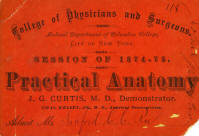John Green Curtis, M.D.
Click on image to enlarge
Name: John Green Curtis
Death date: Sep 20, 1913
Place of death: New York, NY
Type of practice: Allopath
Journal of the American Medical Association Citation: 61:1390John Green Curtis, M. D., LL. D., youngest child of George and Julia B. (Bridg- ham) Curtis, was born October 25, 1844, in New York City, and died September 20, 1913, at Chatham, Massachusetts. He was educated in private schools and with private tutors in New York City and was graduated from Harvard University, A. B. in 1860, and received the degree of M. A. in 1869. Returning to New York, he entered the College of Physicians and Surgeons, Medical Department of Columbia University, from which he graduated, M. D., in 1870. While pursuing his studies, he served as junior assistant in the first surgical division of the staff of Bellevue Hospital from April i to September 30, 1869; as senior assistant from October, 1869, to March 31, 1870, and as house surgeon from April i to October, 1870. He also filled the position of visiting surgeon from 1876 to 1881. In 1870 he began the practice of medicine and in 1872 entered into partnership as junior partner with Dr. Henry B. Sands.
Early in his career he became associated with the teaching staff of the College of Physicians and Surgeons and held successively the following positions: Assistant demonstrator of anatomy. 1870 and 1871; demonstrator of anatomy, 1871 to 1875; adjunct lecturer on physiology, 1875 and 1876; adjunct professor of physiology, 1876 to 1883; professor of physiology, 1883 to 1909. In that year he retired from active duty and was appointed professor emeritus of physiology. He was also secretary of the Faculty of Medicine from 1876 to 1890; for six years a member of the University Council of Columbia University, and for one year dean of the Faculty of Medicine.
At the outset of his career he became interested in the science of Physiology and upon his retirement from private practice in 1883 he gave that department of science his exclusive attention. He was instrumental in introducing in America the laboratory method for the demonstration and investigation of physiology, and under his care the laboratory at the College of Physicians and Surgeons became an important factor in the city's scientific life and one of the leading American centers of physiological science. He was a founder of the American Physiological Society, and one of the authors of "An American Text Book of Physiology." He made a special study of the early history of physiology and of the doctrines of the ancient Greek and Roman and medieval philosophers and physicians, and in
the course of his researches acquired a library of the works of these writers which has been rarely surpassed. In 1900 he delivered the Cartwright lectures at the New York Academy of Medicine on "The Discovery of the Nerves and of their Functions." In 1907, by invitation, he lectured at Johns Hopkins University on "Harvey's Views of the Use of the Circulation." In 1904 Columbia University conferred on him the degree of LL. D.
He married (first) October 20, 1874, Mrs. Martha (McCook) Davis, widow of Dupont Alexander Davis and daughter of Major Daniel McCook, of Ohio. Mrs. Curtis died in 1897. Dr. Curtis married (second) December 13, 1902, Netta E. Blackwood, daughter of Henry James Blackwood, of Norwich, England.
SCIENTIFIC CHICANERY.
[Extracts from document published by the American Humane Association.] 1
In the Senate report on vivisection, issued in 1896, there appears a " statement in behalf of science," signed by some forty American vivi- sectors or investigators, asking in effect that the practice of animal experimentation be continued free from Government supervision or control. To increase the importance of this manifesto it was introduced to the public by a special letter, signed, among others, by Dr. Charles W. Eliot, the president of Harvard University, vouching for it as a statement which " may be accepted as an authoritative expression of expert opinion." Its opening sentences were as follows:
" So long ago as the autumn of I866 there were published in New York denunciations of the practice of making upon living animals those scientific observations and experiments which are commonly called vivisections. During the following twenty-nine years there have appeared from time to time similar denunciations, more or less sweeping and violent. Of these some condemn vivisection altogether, and others in various of its phases. Some call for its total abolition, and others for its material restriction. Some are labored essays, and others are brief 'tracts'or 'leaflets,'in tended more easily to arrest the attention. * * * In these publications, too, there often figure extracts from scientific writings, and in many cases these extracts are so garbled that only ignorant or reckless animosity could be accepted in excuse for their seeming bad faith."'
Among the signatures to this document were the following names:
S. Weir Mitchell, M. D., Philadelphia, Pa., member of the National Academy of Sciences.
J. G. Curtis, M. D., professor of physiology, College of Physicians and Surgeons, Columbia College, New York.
W. H. Howell, M. D., professor of physiology, Johns Hopkins Dni- verity, Baltimore, Md.
H. P. Bowditch, M. D., professor of physiology, Harvard Medical School, Harvard University, Boston, Mass.
W. T. Porter, M. D., assistant professor of physiology, Harvard Medical School, Harvard University, Boston, Mass.
J. W. Warren, M. D., associate professor of physiology, Bryn Mawr College, Byrn Mawr, Pa.
E. H. Cuittenden, Ph. D., professor of physiological chemistry, Yale University, New Haven, Conn.
